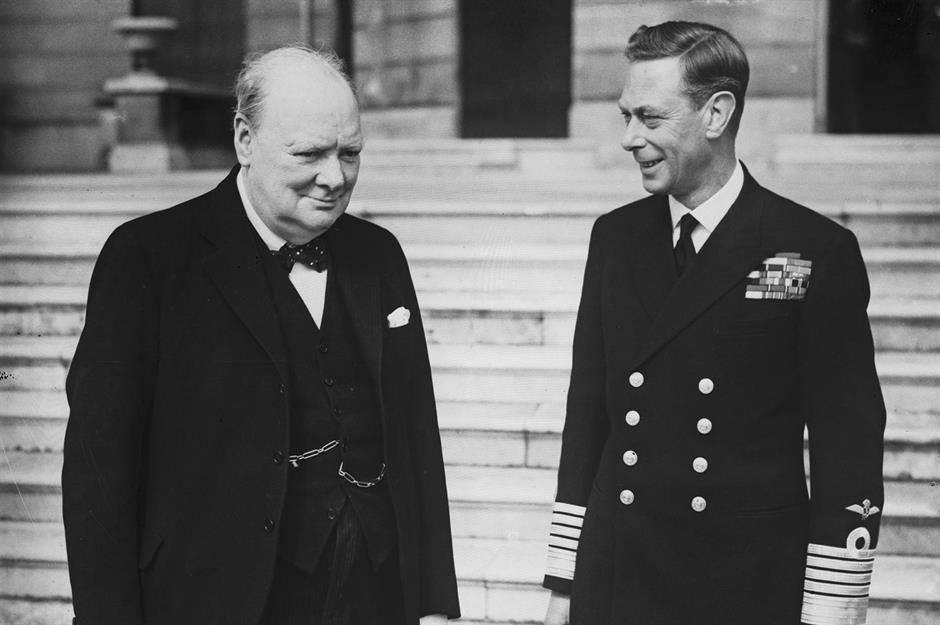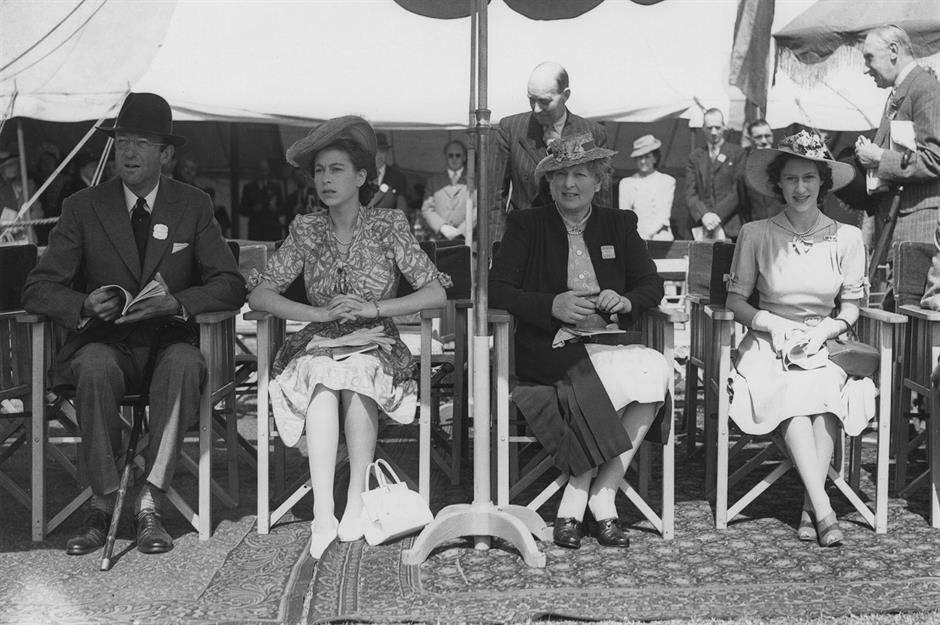How the rich lived in the Second World War
How did conflict affect the super-rich?
The British Royal Family
You’d be forgiven for thinking that the royals lived like, well, royalty, during the war. King George VI, who reigned between 1936-1952, may have lived between Buckingham Palace and Windsor Castle – yet he and his family still had to ration everything from food to bath water. Pictured here are the Duke and Duchess of Beaufort (far left and centre right) with Princess Elizabeth (centre left), who we now know as Queen Elizabeth II, and her sister Princess Margaret (far right).
The British Royal Family
The royals experienced the same dangers as the rest of the population. In fact, Buckingham Palace was bombed nine times during the war, and twice within three days in September 1940. During the second of these September attacks the King and Queen were actually in the Palace, but managed to escape unharmed. During the war years King George VI (pictured right) struck up a close – if unlikely – friendship with Winston Churchill, the British Prime Minister. They got on so well that the weekly audience between King and Prime Minister soon became informal Tuesday lunches with no staff present. Sometimes they were even interrupted by air raids.
The British Royal Family
Meanwhile, the Duke and Duchess of Beaufort had to give up most of their home to King George VI's mother, Queen Mary, who was the Duchess' aunt. She is pictured here in her youth in 1905. Allegedly, she arrived carrying more than 70 pieces of luggage and had 50 members of staff in tow, taking over all but two bedrooms and a sitting room, which were left for the Duke and Duchess.
The Mountbattens
The Mountbattens
The Mountbattens
Edwina also had a bit of a reputation. She was known as one of the most beautiful women in the country and was unflatteringly described in her daughter’s memoir as a “man eater”. She had many affairs, the most famous of which was with Indian Prime Minister Jawaharlal Nehru. Edwina met him after the war when the couple moved to India in 1947 so that Louis could fulfill his role as the last Viceroy of India, helping to oversee India’s transition to independence.
The Astors
Nancy and Waldorf Astor, both American expats living in the UK, got married in 1906. They were gifted the Astor family estate, Cliveden House in Buckinghamshire, which Waldorf’s father William had bought in 1893 for $1.2 million – equivalent to $34 million (£28m) today. The ‘Cliveden Set’ was the name given to the social group that grew around them, with the house becoming something of a social hub where everyone from Charlie Chaplin to Mahatma Gandhi came to visit.
The Astors
Nancy Astor was Britain’s first female MP to take her seat, serving in parliament between 1919 and 1945. As a member of the Unionist Party (now the Conservative Party), she gained a reputation for being an outspoken rule-breaker. Both Nancy and Waldorf were against the Second World War, and their Cliveden set was known for supporting appeasement with Hitler. This led them to often be accused to be fascists, although they denied this. Nancy changed her opinion on the war when the Germans invaded Prague, and despite their reservations they supported local people in her Plymouth constituency during bombings. Nancy left politics in 1945, following her increasingly erratic behaviour.
The Astors
Osman Ali Khan, Nizam of Hyderabad
Osman Ali Khan, Nizam of Hyderabad
The Nizam had the famous Golconda mines to thank for his affluence, which helped to make Hyderabad state the only global supplier of diamonds. His wealth was legendary: making an appearance on the cover of Time magazine in 1937, he was labelled the richest man in the world, and he owned an impressive diamond collection including the 185-carat Jacob Diamond, ranked as the fifth largest in the world. During the Second World War he provided military support to the Allies, lending naval ships and two Royal Air Force squadrons. When the war ended he was awarded the Royal Victorian Chain for his aid. He is pictured here bowing to King George V and Queen Mary in 1911 when they visited the Delhi Durbar, held to celebrate their coronation.
The Rockefellers
The Rockefellers
Nelson A. Rockefeller, grandson of John D. Rockefeller I, was head of US activities in Latin America, helping to improve its relations with the West and counter rising Nazi influence. David Rockefeller, Nelson's younger brother, enlisted in the army in 1943, while also assisting with military intelligence in North Africa in France. Pictured is Nelson and David's eldest brother John D. Rockefeller III (left) at Claridge’s in London in 1946, as he pledged to give away $10 million to fund postwar Europe.
The Rockefellers
The Rockefellers also had an interesting link with the UK wartime Prime Minister. Searching for a biographer to chronicle their family heritage in the 1930s, they approached Winston Churchill, who was well-known for his writing talent and penned 42 books in his lifetime. Yet Churchill’s request of $250,000 for the task – equivalent to around $4.7 million (£3.8m) today – was too steep, so they ultimately got a Columbia University historian to do it instead.
Read From Rockefellers to Rothschilds: how five old-money dynasties live today
The Morgans
The Morgans
The Morgans
Henry Ford and family
The prolific industrialist Henry Ford was a pacifist, so initially opposed US involvement in the Second World War. Yet when the Japanese bombed Pearl Harbour, he changed tack, building a new factory in Detroit in 1941 to produce military aircrafts. Completed in 1942, the Willow Run factory (pictured) was the largest in the world, with 42,000 workers completing a bomber nearly every hour – utilising Ford’s famous production line, of course.
Discover 30 entrepreneurs who changed America and then the world
Henry Ford and family
Yet Ford’s support of the US was problematic. In 1939, he was still doing business with Nazi Germany, which included manufacturing weapons and military equipment. What’s more, Ford-Werke, the German branch of the company, started hiring French Prisoners of War to work as slave labourers in 1940, although this halted when the US entered the war a year later.
Henry Ford and family
Edsel Ford (pictured right), Henry and his wife Clara’s only child, was president of the Ford Motor Company between 1919 and 1943. Managing the Willow Run factory, it’s been alleged that the immense pressure of the job led to his ill health, with Edsel developing stomach cancer and passing away in 1943. His son, Henry Ford II (pictured left) was serving in the Navy at this time and so didn't take up the role of president of the Ford Motor Company until 1945.
J. Paul Getty
J. Paul Getty
As well as his reputation for infidelity and extreme stinginess, recently released documents suggest the business magnate had another dark side. He was linked to a shadowy bunch of bankers, who helped to supply the Nazis with fuel in the early years of the war, as well as a fraudster named Serge Rubinstein who helped run his business in London. He was also said to have been involved in a deal supplying Mexican oil to Germany during the war.
J. Paul Getty
During the war, Getty was married to singer Louise Dudley Theodora Lynch, known by the nickname Teddy. Yet the couple quickly drifted after their marriage in 1939, with Teddy studying in Italy and Getty working obsessively. Teddy was briefly put behind bars while in Italy, after being found by Mussolini’s fascists and suspected to be a spy.
J. Paul Getty's incredible life with all the money in the world
The Rothschilds
The Rothschilds were a Jewish banking family, whose business was founded by Amschel Mayer Rothschild (pictured) in the 1760s. The family had branches in Vienna, Naples, France and England. Philippe de Rothschild, a prominent member of the French branch, was called up to serve in the French Air Force. Yet he was arrested in Algeria, and his citizenship revoked in September 1940 reportedly because he had left France without official permission. He left France for England. When he returned after the war he discovered that, tragically, his estranged wife Élisabeth Pelletier de Chambure had been sent to a concentration camp where she died in 1945.
The Rothschilds
As for the Austrian branch of the family, they had a large collection of art, jewellery and antiques stolen by the Nazis in 1938, when the Third Reich annexed Austria. The items were kept to the west of Vienna, away from military zones, until after the war, when the family begun a lengthy quest to get them back. In the 1990s, after nearly five decades of bargaining with the Austrian government, the items were finally returned.
The Rothschilds
Over in the UK, Anthony de Rothschild and his wife Yvonne (pictured with her children) had noticed tensions in Europe as early as the 1930s. In autumn 1933, Yvonne became president of a society which aimed to help German Jewish women and children, while in 1938 Anthony became chair of the Emigration Committee of the Council of the German Jewry. Anthony’s private letters reveal his involvement in helping Jewish refugees with resettlement during the war.
Discover Treasures the Nazis stole that were sensationally recovered

